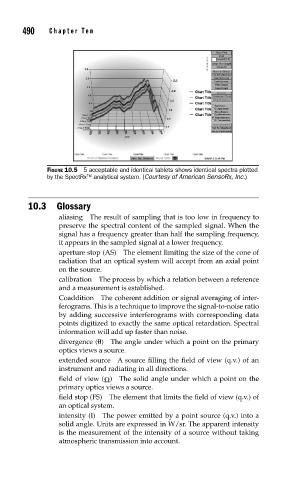Page 537 - Sensors and Control Systems in Manufacturing
P. 537
490
Cha p te r
T e n
FIGURE 10.5 5 acceptable and identical tablets shows identical spectra plotted
by the SpectRx™ analytical system. (Courtesy of American SensoRx, Inc.)
10.3 Glossary
aliasing The result of sampling that is too low in frequency to
preserve the spectral content of the sampled signal. When the
signal has a frequency greater than half the sampling frequency,
it appears in the sampled signal at a lower frequency.
aperture stop (AS) The element limiting the size of the cone of
radiation that an optical system will accept from an axial point
on the source.
calibration The process by which a relation between a reference
and a measurement is established.
Coaddition The coherent addition or signal averaging of inter-
ferograms. This is a technique to improve the signal-to-noise ratio
by adding successive interferograms with corresponding data
points digitized to exactly the same optical retardation. Spectral
information will add up faster than noise.
divergence (θ) The angle under which a point on the primary
optics views a source.
extended source A source filling the field of view (q.v.) of an
instrument and radiating in all directions.
Ω
field of view ( ) The solid angle under which a point on the
primary optics views a source.
field stop (FS) The element that limits the field of view (q.v.) of
an optical system.
intensity (I) The power emitted by a point source (q.v.) into a
solid angle. Units are expressed in W/sr. The apparent intensity
is the measurement of the intensity of a source without taking
atmospheric transmission into account.

